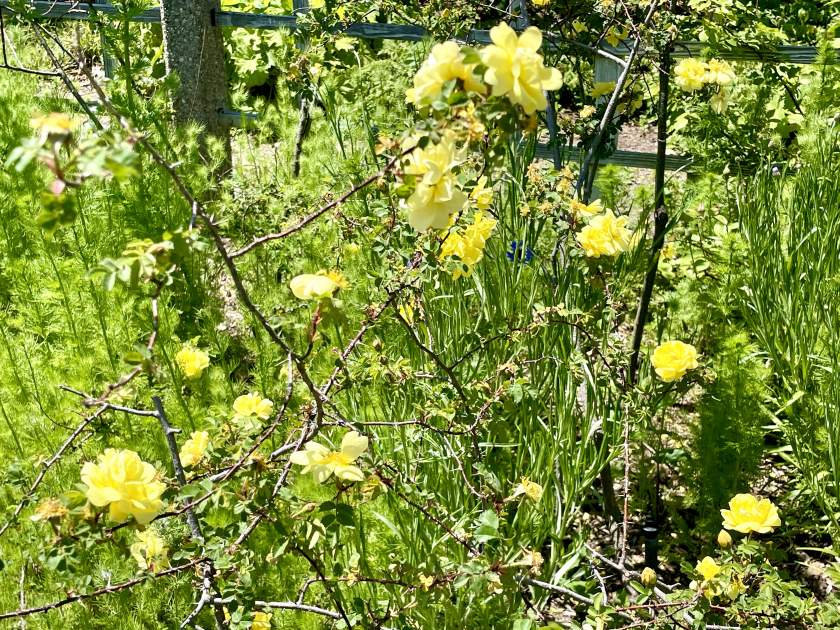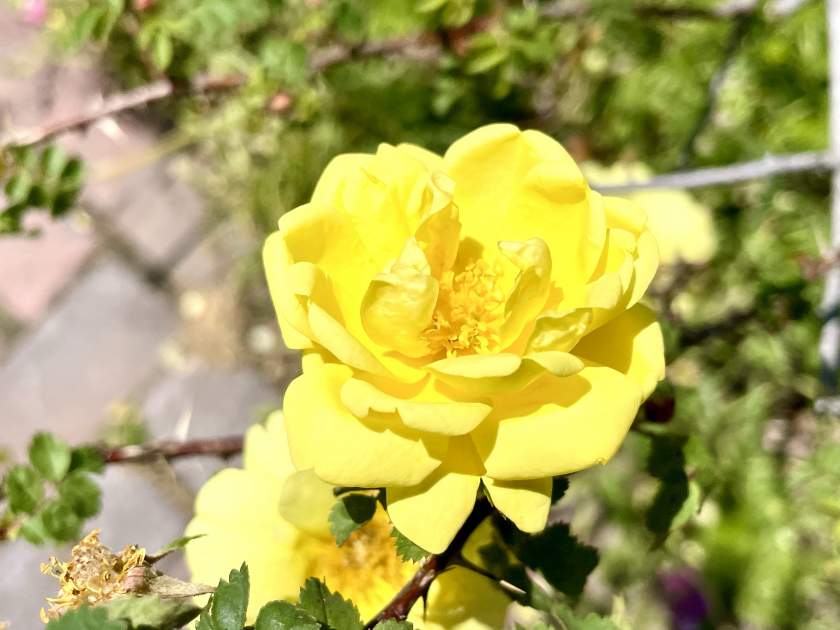The Timeless Beauty of Rosa ‘Harison’s Yellow’: A Captivating Heritage Rose
Rosa ‘Harison’s Yellow’, a remarkable rose cultivar, holds a rich history and an enduring charm. It originated as a chance hybrid in the early 19th century, likely a seedling of Rosa foetida and Rosa pimpinellifolia. The first blooms of this cultivar emerged at the suburban villa of George Folliott Harison, an attorney, located between 8th and 9th Avenues on 32nd Street, north of New York City.
The site of Harison’s villa now rests just south of the present General Post Office. William Prince, a renowned nurseryman from Flushing, Long Island, obtained cuttings and introduced the rose to the market in 1830. Over time, ‘Harison’s Yellow’ has naturalized at abandoned house sites throughout the western regions and can be found as a feral rose along the Oregon Trail.
Other names: Rosa ‘Harison’s Yellow’ is also known as Rosa × harisonii, Rosa Spinossisima ‘Harisonii’, the Oregon Trail Rose, or the Yellow Rose of Texas. This plant is part of the Rosaceae family of plants.
In 2009, the Heritage Rose Foundation planted Rosa ‘Harison’s Yellow’ near the grave of George Folliott Harison. Today, this planting stands as a significant part of the Heritage Rose District of NYC, honoring its historical legacy.
Characteristics:
The ‘Harison’s Yellow’ rose captivates with its semi-double, clear yellow flowers. Each blossom boasts an average diameter of 5 to 6 centimeters (2.0 to 2.4 inches) and carries up to 25 petals. The slightly cupped blooms appear in clusters during an early spring flush, gracing the landscape for three to four weeks. Their fruity fragrance adds a delightful sensory experience to the garden.
This cultivar showcases small, greenish-grey leaves with seven to nine leaflets and possesses prickles along its stems. As the season progresses, ‘Harison’s Yellow’ develops numerous small, globular rose hips. Initially green, the hips mature into vibrant red before transitioning to black, reaching an average diameter of 1.5 centimeters (0.59 inches). The bushy shrub grows suckers on its own roots, reaching a height and width of 1 to 1.75 meters (3.3 to 5.7 feet). Notably, ‘Harison’s Yellow’ exhibits impressive resilience, tolerating drought, shade, and poorer soils. It requires minimal care and showcases exceptional winter hardiness, enduring temperatures as low as −35 °C (USDA zone 4). It can be planted as a solitary specimen, grouped together, or utilized as hedges.
Cultivation of Rosa ‘Harison’s Yellow’:
Planting: Rosa ‘Harison’s Yellow’ thrives in full sun and well-drained soil. It prefers slightly acidic soil with a pH of 6.0-6.5. To ensure proper air circulation, space the rose plants at least 3 feet apart.
Watering: Regular watering is essential for Rosa ‘Harison’s Yellow’, particularly during hot and dry weather. Maintain moist soil, avoiding excessive saturation.
Fertilizing: Monthly fertilization during the growing season with a balanced fertilizer is beneficial for Rosa ‘Harison’s Yellow’. Consider using a fertilizer with a high potassium content to promote abundant flowering.
Pruning: Spring pruning is recommended for Rosa ‘Harison’s Yellow’ to remove any dead or damaged wood and to shape and control its size.
Deadheading: Regular deadheading of spent flowerheads is advised to stimulate new blooms. Simply pinch off the faded flowers using your fingers.
Protection from pests and diseases:
Rosa ‘Harison’s Yellow’ exhibits resistance to a wide range of pests and diseases. However, it may be susceptible to black spots and powdery mildew. Combat black spots with appropriate fungicides, while powdery mildew can be treated by spraying a mixture of water and baking soda onto the affected leaves.
Winter protection: Although Rosa ‘Harison’s Yellow’ is highly resilient to cold winters, it is advisable to provide protection against harsh weather conditions. Consider covering the rose plant with a burlap sack or other protective materials.

Propagation of Rosa ‘Harison’s Yellow’:
Rosa ‘Harison’s Yellow’ can be propagated through cuttings or layering.
Cuttings: Select a healthy, 6-inch long stem for taking cuttings from Rosa ‘Harison’s Yellow’. Remove the leaves from the bottom half of the cutting, dip the cut end in the rooting hormone, and plant it in a well-drained potting mix. Keep the soil consistently moist, and within 4-6 weeks, the cutting should develop roots.
Layering: To propagate Rosa ‘Harison’s Yellow’ through layering, choose a low-hanging branch. Make a cut in the bark of the branch and gently bend it down, burying it in the soil. Over time, the branch will root and form a new plant.
Rosa ‘Harison’s Yellow’ stands as an enduring testament to the captivating beauty and historical significance of heritage roses. With its vibrant yellow blooms, delightful fragrance, and remarkable adaptability, this cultivar continues to captivate gardeners and rose enthusiasts alike. Embrace the allure of ‘Harison’s Yellow’ and experience the timeless elegance it brings to your garden.




